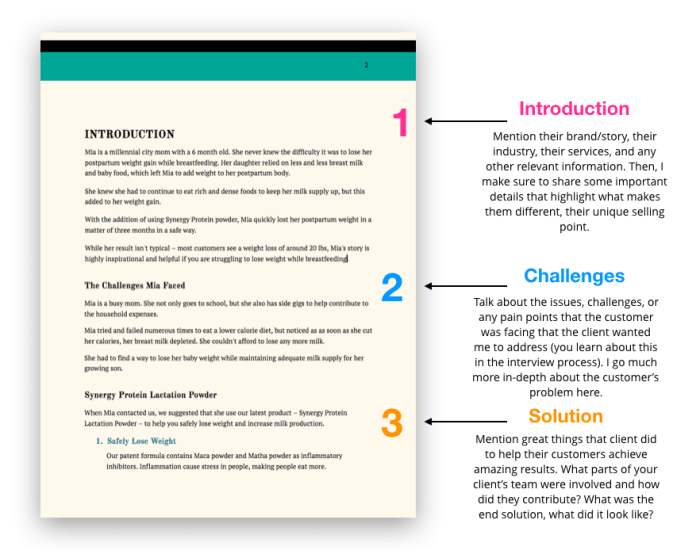Writing Case Studies opens the door to a world of storytelling magic, where real-life examples and data analysis come together in a captivating narrative. Get ready to dive into the realm of research and business with unexpected twists and insights!
Introduction to Writing Case Studies
A case study is a detailed analysis of a person, group, event, or situation that aims to provide a comprehensive understanding of the subject. In research or business, case studies are used to investigate complex phenomena, explore real-life scenarios, and draw practical lessons that can be applied in similar contexts.
The typical structure of a case study includes an introduction that sets the stage for the study, background information to provide context, methodology outlining the research approach, results presenting findings, and a conclusion summarizing key points and insights.
Examples of Industries or Fields Using Case Studies
- Marketing: Case studies are commonly used in marketing to showcase successful campaigns, analyze consumer behavior, and demonstrate the effectiveness of strategies.
- Healthcare: In the healthcare industry, case studies are utilized to examine medical conditions, treatment outcomes, and best practices in patient care.
- Education: Case studies play a significant role in education by presenting teaching methods, student performance, and innovative approaches to learning.
Importance of Case Studies
Case studies are an essential research method that offers numerous benefits to researchers and readers alike. They allow for a detailed examination of a particular subject, providing in-depth insights and a thorough understanding. By delving deep into a specific case, researchers can uncover unique perspectives and valuable information that may not be apparent through other research methods.
Benefits of Using Case Studies
- Case studies provide a detailed analysis of a specific situation, allowing researchers to explore complex issues in real-world contexts.
- They offer a holistic view of a subject, considering various factors that contribute to a particular outcome or phenomenon.
- Case studies enable researchers to identify patterns, trends, and relationships that may not be evident in broader research studies.
Impactful Case Studies, Writing Case Studies
- The Stanford Prison Experiment conducted by Philip Zimbardo is a classic example of a case study that revealed the powerful influence of situational factors on human behavior.
- The case study of Phineas Gage, a railroad worker who survived a traumatic brain injury in the 19th century, provided valuable insights into the relationship between brain function and personality.
- The case study of Genie, a young girl who was kept isolated and abused for years, shed light on the critical period hypothesis and the effects of extreme deprivation on development.
Strategies for Writing Effective Case Studies

When it comes to writing effective case studies, there are several key strategies to keep in mind. From choosing the right subject to collecting data and organizing your findings, these steps are crucial to creating a compelling and informative case study.
Choosing the Right Subject for a Case Study
Selecting the right subject for your case study is essential. Look for a topic that is relevant, interesting, and offers valuable insights to your target audience. Consider real-life examples or unique situations that can provide a learning opportunity or solution to a common problem.
Collecting Data and Information
Gathering accurate and relevant data is vital to the success of your case study. Utilize a variety of research methods such as interviews, surveys, and data analysis to ensure you have a comprehensive understanding of the subject. Make sure to cite your sources and validate the information to maintain credibility.
Structuring and Organizing a Case Study
Proper organization is key to a well-written case study. Start by outlining the main points you want to cover and create a logical flow of information. Use headings, subheadings, and bullet points to break down complex data and make it easier for readers to follow. Remember to include a clear introduction, background information, analysis, and a conclusion to tie everything together seamlessly.
Elements of a Compelling Case Study

When creating a compelling case study, it is essential to include key elements that can engage readers and provide valuable insights. These elements help in crafting a narrative that is not only informative but also captivating.
Real-life Examples
Including real-life examples in a case study adds authenticity and credibility to the content. Readers can relate to concrete situations and better understand the challenges and solutions presented in the case study.
- Provide detailed scenarios that showcase the problem or issue faced by the subject of the case study.
- Include specific details such as names, dates, and locations to make the examples more vivid and realistic.
- Use quotes or testimonials from individuals involved to add a human touch to the narrative.
Data Analysis
Incorporating data analysis in a case study is crucial for supporting claims and recommendations. Data-driven insights can strengthen the argument presented and provide a clear understanding of the outcomes achieved.
Utilize charts, graphs, and statistics to visually represent the data and make it easier for readers to comprehend.
- Analyze key metrics or performance indicators to demonstrate the impact of the solutions implemented.
- Compare data before and after the implementation of strategies to highlight improvements or changes.
- Explain the methodology used for data collection and analysis to ensure transparency and credibility.
Recommendations
Including recommendations in a case study is essential for providing actionable insights to readers. Recommendations offer practical solutions and strategies that can be implemented in similar situations.
- Provide clear and concise recommendations based on the analysis conducted in the case study.
- Suggest specific actions or steps that can be taken to address the identified challenges or opportunities.
- Explain the rationale behind each recommendation and how it can lead to positive outcomes.
